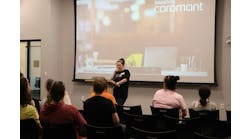The Robotic Industries Association (RIA) announced Esben as the recipient of the Engelberger Robotics Award. Østergaard spearheads the development of Universal Robots’ collaborative robot arms. The Engelberger Awards Dinner and Ceremony will be held at 6:30pm on Wednesday, Jun. 20 at the Hofbräuhaus in Munich, Germany as part of Automatica and the International Symposium on Robotics.
"Esben Østergaard’s emphasis on robots that work side-by-side with people and are easy to use has created enormous interest among many small and medium sized companies who never even considered robots before," said president of RIA, Jeff Burnstein. "His work in the field of collaborative robot applications has allowed robots to enter previously unthinkable sectors in just about every industry. In a world that is increasingly characterized by people and robots working together, Esben’s pioneering technology advances play a pivotal role.”
According to Universal Robots, its 2008 launch of the world’s first commercially viable robot able to operate safely outside enclosures alongside people came at great financial risks in a market unaccustomed to human-robot collaboration. Esben Østergaard and his team offered the industry a robot that was not only safe to work with but also lightweight, easy to use and flexible. These accomplishments have helped Universal Robots take a current 58 percent share of all cobots sold worldwide, posting a 72 percent growth in 2017.
“I’m deeply honored to win the award named after Joseph Engelberger, who revolutionized industrial manufacturing with robotics,” said Østergaard. “Engelberger’s view that a robot should be able to handle a range of tasks in a factory aligns with Universal Robots’ core mission, and I’m a great admirer of his work.”
Østergaard leads a team of developers that became the first to launch project with 3D robot programming via an intuitive tablet interface. This has enables users with no programming experience the ability to set up and operate the UR robots. He also developed the robot’s force and safety control features, which ensure that if the robot collides with a person, the robot automatically stops operating and does not cause bodily harm, adhering to the current safety requirements on force and torque limitations.
“We want to place control of factory automation back into the hands of operators, instead of replacing people we want to give them a tool to do their work more efficiently,” said Østergaard. “We want to remove them from working like robots to becoming robot programmers and handling more value-added tasks. Doing this will perhaps be the best long-term result derived from leveraging collaborative robots. This redeployment of human creativity interspersed with the robot’s repeatability addresses the market evolvement and customer requirements demanding a high degree of product individualization. It’s qualitative change both in the products made and for the people making them.”



